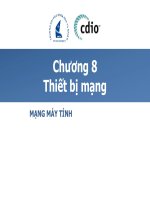Tài liệu mạng máy tính nâng cao transmision protocol
Bạn đang xem bản rút gọn của tài liệu. Xem và tải ngay bản đầy đủ của tài liệu tại đây (6.62 MB, 115 trang )
Chapter 12
Transmission
Control Protocol
Objectives
Upon completion you will be able to:
• Be able to name and understand the services offered by TCP
• Understand TCP’s flow and error control and congestion control
• Be familiar with the fields in a TCP segment
• Understand the phases in a connection-oriented connection
• Understand the TCP transition state diagram
• Be able to name and understand the timers used in TCP
• Be familiar with the TCP options
TCP/IP Protocol Suite
CuuDuongThanCong.com
/>
1
Figure 12.1
TCP/IP protocol suite
TCP/IP Protocol Suite
CuuDuongThanCong.com
/>
2
12.1 TCP SERVICES
We explain the services offered by TCP to the processes at the application
layer.
The topics discussed in this section include:
Process-to-Process Communication
Stream Delivery Service
Full-Duplex Communication
Connection-Oriented Service
Reliable Service
TCP/IP Protocol Suite
CuuDuongThanCong.com
/>
3
Table 12.1 Well-known ports used by TCP
TCP/IP Protocol Suite
CuuDuongThanCong.com
/>
4
Example 1
As we said in Chapter 11, in UNIX, the well-known ports are
stored in a file called /etc/services. Each line in this file gives
the name of the server and the well-known port number. We
can use the grep utility to extract the line corresponding to the
desired application. The following shows the ports for FTP.
$ grep ftp /etc/services
ftp-data
ftp-control
20/tcp
21/tcp
TCP/IP Protocol Suite
CuuDuongThanCong.com
/>
5
Figure 12.2
Stream delivery
TCP/IP Protocol Suite
CuuDuongThanCong.com
/>
6
Figure 12.3
Sending and receiving buffers
TCP/IP Protocol Suite
CuuDuongThanCong.com
/>
7
Figure 12.4
TCP segments
TCP/IP Protocol Suite
CuuDuongThanCong.com
/>
8
12.2 TCP FEATURES
To provide the services mentioned in the previous section, TCP has
several features that are briefly summarized in this section.
The topics discussed in this section include:
Numbering System
Flow Control
Error Control
Congestion Control
TCP/IP Protocol Suite
CuuDuongThanCong.com
/>
9
Note:
The bytes of data being transferred in
each connection are numbered by TCP.
The numbering starts with a randomly
generated number.
TCP/IP Protocol Suite
CuuDuongThanCong.com
/>
10
Example 2
Suppose a TCP connection is transferring a file of 5000 bytes.
The first byte is numbered 10001. What are the sequence
numbers for each segment if data is sent in five segments, each
carrying 1000 bytes?
Solution
The following shows the sequence number for each segment:
Segment 1 ➡ Sequence Number: 10,001 (range: 10,001 to 11,000)
Segment 2 ➡ Sequence Number: 11,001 (range: 11,001 to 12,000)
Segment 3 ➡ Sequence Number: 12,001 (range: 12,001 to 13,000)
Segment 4 ➡ Sequence Number: 13,001 (range: 13,001 to 14,000)
Segment 5 ➡ Sequence Number: 14,001 (range: 14,001 to 15,000)
TCP/IP Protocol Suite
CuuDuongThanCong.com
/>
11
Note:
The value in the sequence number
field of a segment defines the number
of the first data byte contained
in that segment.
TCP/IP Protocol Suite
CuuDuongThanCong.com
/>
12
Note:
The value of the acknowledgment field
in a segment defines the number of the
next byte a party expects to receive.
The acknowledgment number is
cumulative.
TCP/IP Protocol Suite
CuuDuongThanCong.com
/>
13
12.3 SEGMENT
A packet in TCP is called a segment
The topics discussed in this section include:
Format
Encapsulation
TCP/IP Protocol Suite
CuuDuongThanCong.com
/>
14
Figure 12.5
TCP segment format
TCP/IP Protocol Suite
CuuDuongThanCong.com
/>
15
Figure 12.6
Control field
TCP/IP Protocol Suite
CuuDuongThanCong.com
/>
16
Table 12.2 Description of flags in the control field
I
TCP/IP Protocol Suite
CuuDuongThanCong.com
/>
17
Figure 12.7
Pseudoheader added to the TCP datagram
TCP/IP Protocol Suite
CuuDuongThanCong.com
/>
18
Note:
The inclusion of the checksum in TCP
is mandatory.
TCP/IP Protocol Suite
CuuDuongThanCong.com
/>
19
Figure 12.8
Encapsulation and decapsulation
TCP/IP Protocol Suite
CuuDuongThanCong.com
/>
20
12.4 A TCP CONNECTION
TCP is connection-oriented. A connection-oriented transport protocol
establishes a virtual path between the source and destination. All of the
segments belonging to a message are then sent over this virtual path. A
connection-oriented transmission requires three phases: connection
establishment, data transfer, and connection termination.
The topics discussed in this section include:
Connection Establishment
Data Transfer
Connection Termination
Connection Reset
TCP/IP Protocol Suite
CuuDuongThanCong.com
/>
21
Figure 12.9
Connection establishment using three-way handshaking
TCP/IP Protocol Suite
CuuDuongThanCong.com
/>
22
Note:
A SYN segment cannot carry data, but
it consumes one sequence number.
TCP/IP Protocol Suite
CuuDuongThanCong.com
/>
23
Note:
A SYN + ACK segment cannot carry
data, but does consume one
sequence number.
TCP/IP Protocol Suite
CuuDuongThanCong.com
/>
24
Note:
An ACK segment, if carrying no data,
consumes no sequence number.
TCP/IP Protocol Suite
CuuDuongThanCong.com
/>
25









